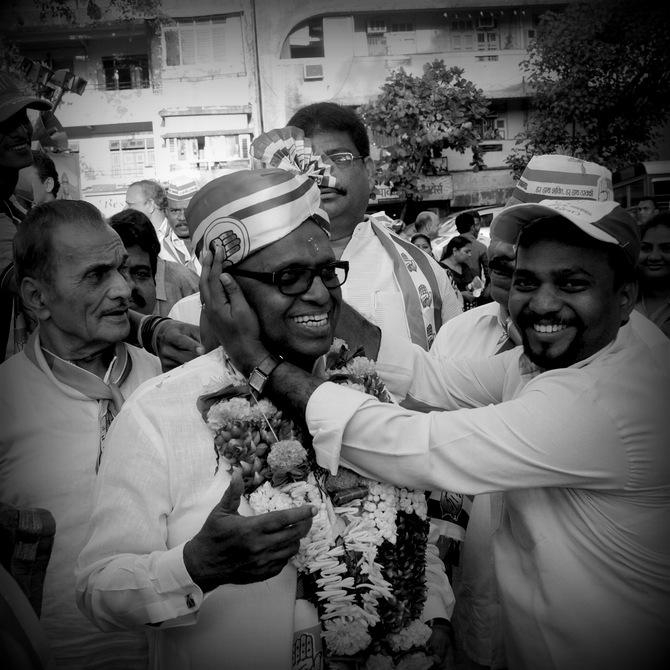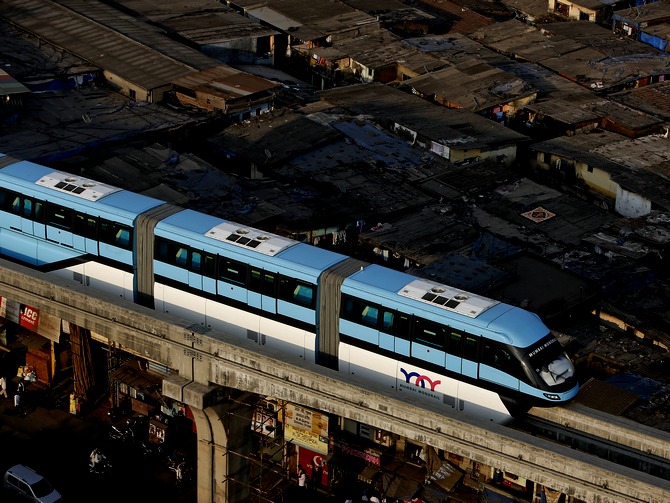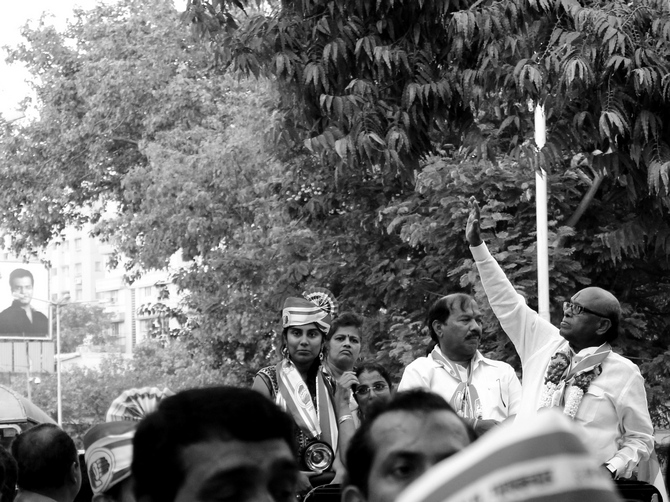
Eknath Gaikwad, a three-time MLA and a two-time MP from Mumbai, hopes to to win a seat in the Lok Sabha the third time over.
But his path to victory confronts more obstacles than ever before.
Rediff.com's Abhishek Mande Bhot finds out why.
Sunday afternoon.
Two boys, no older than ten have found a perfect spot for a game of carrom -- behind the parked truck that has cast a cool shadow on the pavement.
In the backdrop, the imposing structure of the district sports complex.
Located in Dharavi, Mumbai's best-known slum, the complex offers spaces for squash, billiards, badminton, table tennis, basketball, volleyball, swimming and of course carrom.
Completed at a cost of about Rs 25 crore (Rs 250 million; its original budget was Rs 8.25 crore; Rs 82.5 million), the complex, like most government projects was caught in red tape for almost a year before it was finally inaugurated in July 2013.
In less than five months, reports of the complex being in shambles -- cracked tiles in the pool, leakage in the roof, rusting benches, incorrect flooring -- began appearing in the newspapers.
The semi-Olympic-sized swimming pool itself was thrown open to public only about a fortnight ago, just in time before the constituency cast its vote on April 24 for the 2014 general election.
***
Dharavi is part of the Mumbai South Central Lok Sabha constituency.
Representing it since 2004 is this man in the picture above -- the Congress party's Eknath Gaikwad.
He has also represented the area in the state assembly for three terms before relinquishing it for his daughter, Varsha Gaikwad.
Some believe the 74-year-old Eknath Gaikwad is on a sticky wicket.
Dharavi, once his bastion, has slipped out of his hands.
In the 2002 Mumbai Municipal Corporation election, the Congress party held all the six civic wards in Dharavi.
Ten years later, in 2012, they retained just one with a shocking margin of less than 100 votes.
If he is rattled by this, Gaikwad doesn't show it as he settles for an interview to Rediff.com's Abhishek Mande Bhot in his election office.
Please ...

What would you count as your major successes in the last five years?
I am in touch with my people and I understand their issues.
At the Centre, my government has passed the Food Security Bill; it has passed the Right to Information and the Right to Education Act.
Because of my efforts, the Mumbai Monorail runs within (a part of) my constituency.
We have also constructed the District Sports Complex in Dharavi so people in the area have better access to sports facilities.
Most railway stations in my constituency have an outstation reservation centre. So locals don't have to travel to Dadar or Mumbai Central or CST to book their outstation tickets.
In Dharavi we have completed a socio-economic survey that will help us construct a world class township.
The (redevelopment) plan we have for Dharavi is a solid one and one that can be replicated across slums in the city.
***
Experts have panned the monorail project as being an ineffective one right from the start.
The Harbour line (that touches large parts of Gaikwad's constituency) carries, on an average, 1.2 million people every day according to Mumbai Environment and Social Network, MESN, an NGO for traffic management.
Every nine-coach suburban local train has a capacity of about 2,500 passengers, though twice as many people or more use it during the peak hours.
On the other hand, a single monorail vehicle can carry no more than 568 passengers.
If recent newspaper reports are to be believed, the monorail has been registering a loss of Rs 500,000 every day.
Trupti Amritwar Vaitla, CEO, MESN, believes the Mumbai Monorail project has been haphazardly planned.
"Stations are in the middle of nowhere," she says.
"The last-mile connectivity has not been considered at all. Getting public transport from the station is difficult."
"At a time when the city is struggling with congestion, it is sad that we invest so much in so-called public transport that is unusable."
"Instead, we could have simply focussed on other cheaper alternatives like improving the existing public transport or focussed on road-based public transport where most of the infrastructure is ready."
"All we have," she notes, "are tons of new cars... and one very expensive toy train."
Please ...

As for the ambitious Dharavi Redevelopment Project that proposes to convert what was once Asia's largest slum into some sort of elegant township has dragged on for over a decade.
It has been the platform for both of Varsha Gaikwad's state assembly victories.
Now it seems to have come to haunt her father who had promised to get it rolling during the last election.
Why has the Dharavi Redevelopment Project been delayed so much?
Simple rehabilitation of slums is not the solution to Dharavi.
When the SRA (Slum Rehabilitation Authority) constructs a building, they do not think of other infrastructure issues, simple ones such as sanitation and water supply (are taken for granted).
So also facilities such as schools, parks etc are not taken into account.
It takes time to convince people about these issues -- be it residents or authorities.
Most surveys (for slum rehabilitation) are done by noting the house number and the name of its owner.
We have done a socioeconomic survey of Dharavi in which we've considered how many schools, hospitals, gardens, playgrounds etc will be needed to make Dharavi into a world class township.
And how many schools, hospitals, gardens, playgrounds etc would do you need?
All of that is mentioned in the survey.
***
What complicates matters in Dharavi is that it isn't just a residential area.
Dharavi is one of the most industrialised slums in the world, housing potters, leather tanneries and cloth manufacturing units besides hundreds of other small and medium-sized businesses.
Relocating these trades is far tougher than one can imagine.
Dr Nayreen Daruwala is the director of the programme for prevention of violence against women and children for the NGO Sneha and works in Dharavi.
She says the opinion about the redevelopment project is divided.
"People such as potters and leather tanners are protesting rehabilitation mainly because what they'll get is a 300 square feet flat in which they won't be able to carry out their trade."
"In the current set-up, they have some open space outside of their houses which they make the most of. They use it not just to work but also to sleep in the night or socialise in the day. That space will be gone."
"Their occupations will be severely impacted."
"Their argument is what do we do with better facilities if the source of our livelihood is affected?"
"These people prefer staying in their current conditions in which they have now resigned to living."
***
It is difficult to not sound incredulous while responding to Eknath Gaikwad's remarks:
Dharavi isn't just a residential slum. How are you planning to relocate the industries? The potters for instance...
Kumbharwada (the potters' colony) has outdated furnaces. This is a matter of pollution. We have to get them modern ones, ones that work on gas...
Those that can fit into tiny 300 sq ft houses!?!
Yes!
How is that even possible? Besides it's not just the potters' colony. How do you plan to accommodate leather tanneries, the cloth manufacturing, the dyeing units...?
There are rules for the development project.
According to law they are entitled to houses no larger than 269 sq ft.
I am giving them 300 sq ft.
The fact is that there is no space and you cannot construct towers so tall that they create a fire hazard.
We do have a plan to accommodate industries.
The plan is to have 100 to 150 feet-wide roads; 30-feet wide roads in-between two buildings.
These things have been planned...
And how many years before they turn to reality?
It is a long process, but perhaps about 5, 10 years.
Please ...

Eknath Gaikwad is a Dalit and his caste that has as much to do with his poll fortunes as his work or the lack of it.
Dalits and Muslims form a considerable part of Gaikwad's electorate.
Silvin Kale, an advocate and social activist living in Gaikwad's constituency, cites the approximate Dalit population in various areas.
"90 per cent of the population in the Korba Mithagar locality in Wadala where I live is Dalit."
"Anushakti Nagar has 40 per cent Dalits, Chembur overall has about 70 per cent with the Siddharth Nagar locality in Chembur having 90 per cent Dalits."
"Naigaon has about 60 per cent Dalit population; Dharavi has about 40 to 50 per cent as does the Mankhurd-Govandi belt."
Which would explain Gaikwad's confidence of returning to the Lok Sabha, yet again:
You are a Dalit candidate. What sort of Dalit support do you have in your constituency?
I have been involved with the Ambedkar movement for a long time now and I have strong support in the Dalit community.
The Republican Party of India has not fielded any candidate against me.
What about the Muslims voters?
Muslims won't vote for (Narendra) Modi, definitely not after what happened in Gujarat.
He should have taken responsibility for the riots.
When Maharashtra had riots, we changed the chief minister.
Within three months Sharad Pawar replaced Sudhakar Naik.
***
Silvin Kale, himself a Dalit, believes Gaikwad is walking on thin ice.
Although there are 21 candidates contesting elections from the Mumbai South Central constituency, the fight is between Gaikwad, Rahul Shewale of the Shiv Sena (representing the National Democratic Alliance) and Aditya Shirodkar of the Maharashtra Navnirman Sena.
In the 2009 general election, the MNS ate 20 per cent of the Shiv Sena-BJP combine's votes that helped Gaikwad win.
Kale believes Shirodkar of the MNS won't be in the running and it will all boil down to Shewale, who is also a Dalit, and Gaikwad.
"Chances are that Shewale won't just eat into the Dalit votes, he will bag the saffron votes too," says Kale.
"He has a good working relationship with several parties and is well-known in the Mankhurd-Govandi area."
Since 2010 Shewale has been chairman of the municipal corporation's powerful standing committee that sanctions important projects that deals with Mumbai's crucial infrastructure.
"Moreover, there is an anti-Gaikwad wave," Kale says, adding, ""It isn't just the Dharavi project that will pull him down, but also the fact that he has paid little or no attention to people's needs."
"I live in a slum and the conditions are pathetic. He's done little or nothing to improve them. There is a lot of anger against him."
"And to top it, you also have the anti-Congress wave that could take Gaikwad with it."
***
Back at Eknath Gaikwad's office, I ask him:
If you were to lose this time, what do you think would be the reason?
I won't lose.
My voter base is strong.
My defeat is impossible.